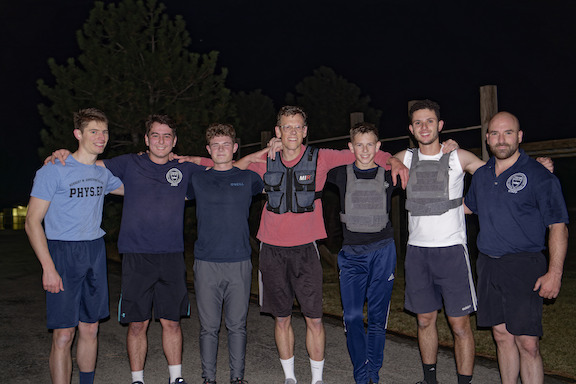Seven of us this year—a couple of newcomers: Zach Williams and Nick Tolis! We finished in 55:52. Beautiful night!

By Noel Brick, Richard Metcalfe, The Conversation
Many top athletes use periodic smiling during performances to relax and cope
A study finds that runners used 2.8% less energy while smiling than frowning
For athletes of all levels, endurance – how long they can keep going at their chosen sport – is made up of physiological and psychological factors.
Physiological factors include cardiovascular fitness, and how efficient an athlete is at using energy (their “movement economy”).
A critical psychological factor, on the other hand, is perceived effort, or how hard we feel we are working during an activity. The lower our perceived effort, the easier we feel that an activity is.
Crucially, any strategy that reduces how much an athlete perceives it to be an effort generally has a positive effect on endurance performance. One of the more surprising approaches could be to deliberately manipulate one’s facial expression.
As peculiar as it may seem, many top athletes, including Olympic marathon gold medallist Eliud Kipchoge, strategically use periodic smiling during performance to relax and cope.
Read more at https://www.cnn.com/2018/02/12/health/smile-running-energy-partner
Below are a couple articles explaining the Zone Diet and how to determine how much to eat. The first article is from the CrossFit journal and it contains some recipes for snacks and meals ranging from one to five blocks.
https://library.crossfit.com/free/pdf/CFJ_2015_05_Zone6.pdfhttps://zonediet.com/resources/food-blocks/
https://journal.crossfit.com/article/nutrition-brief-how-much-food-should-i-eat
For the first few weeks, we recommend keeping track of your food intake with a journal. It will help ensure that are meeting the necessary macronutrient percentages based on your body type and activity load. Here is blank copy of a daily journal.
For time:
100m Walking Lunge
800m Run
100 Air Squats
[WOD = 3 points]
Freshmen version: For reps and distance-
Walking lunges, 2 minutes
Run, 4 minutes (run 2 minutes, then run back to start point)
Squat, 2 minutes
Sunday:
2 mile time trial
Monday
Warm-up/Drills
Pose hold drill: 2x 10-20 seconds each leg; focus on using balance rather than muscular effort to keep pressure on the ball of your foot; finish with 20m jog focusing on running pose
Springiness Position wall-fall drill: Get in springiness position standing 3 ft from wall. Fall by moving hips forward over balls of the feet. Maintain springiness position as you fall forward keeping ankles loos. Catch yourself with your hand. Repeat until you are comfortable letting go and falling.
Timber drill: 10x each leg; fall forward out of pose, keeping body vertical as hips move forward over your support foot; finish w/ 20m jog focus on falling
Change of support drill: 10x each leg; finish w/ 20m jog focus on pulling
View full article »